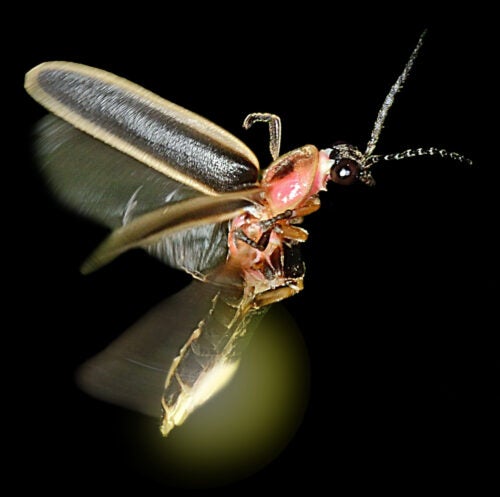
Imagine a warm summer evening on the porch. Flashing fireflies float across the darkening landscape. These lights are mating signals exchanged between males and females. Now, a new study from the Barber Lab at Boise State University has uncovered an additional purpose for these impressive light displays and slow flight patterns: they act as bat deterrents.
Beneath their glowing exterior, many fireflies (which are actually beetles, not flies) contain toxic compounds that make them taste bad to bats. When researchers offered bats chemically defended fireflies, the bats shook their heads and coughed after taking just one bite. To test how fireflies (Photinus pyralis) warn their nocturnal predators that they will not make a good meal, researchers staged battles in a dark flight room on Boise State University’s campus between fireflies and bats that had never previously encountered this prey.
High-speed video footage and ultrasonic acoustic recordings revealed that after four nights of hunting fireflies, bats no longer attempted to catch this prey.
“Since at least the 19th century, naturalists have hypothesized that fireflies warn bats of their offensiveness, and now, we provide definitive evidence,” said Brian Leavell, former manager of the Barber Lab, Ph.D. student at Purdue University, and lead author of a paper on the study recently published in Science Advances.
To test if firefly bioluminescence were warning bats away, the team painted firefly abdomens to extinguish their bioluminescence.
“This was perhaps the most technically difficult part of the study,” said Leavell, “holding the firefly under a microscope and carefully painting the abdomen such that no light could be seen, but the firefly could still fly normally.”
Fireflies with their lights obscured were not nearly as effective at deterring their bat predators. Bats took twice as long to learn to avoid this nasty prey. The researchers concluded that because bats were hunting in a dark room, they were using sonar to avoid darkened fireflies.
What does this mean for predators and prey around the world?
“We demonstrate that bats can learn to avoid fireflies when using sonar or vision, but that they learn faster and more completely when using both — providing fundamental evidence that combining information across senses can increase the power of warning signals,” said Jesse Barber, an associate professor in the Boise State Department of Biological Sciences and the principle investigator of the study.
This work also has important implications for how flashing fireflies came to be.
Marc Branham, an assistant professor in the Department of Entomology and Nematology at the University of Florida, and a coauthor of the paper on the study, emphasized that this new-found anti-predator role for firefly flashing might explain the firefly’s origin.
Barber elaborated.
“Current evolutionary trees-of-life indicate that flashing fireflies appear to have evolved around the same time as bats,” he said. “For fireflies on the wing in the night sky, the predators to avoid have been, and continue to be, bats. We predict that future evolutionary work will reveal that bioluminescence in beetles emerged with bats and that, indeed, bats may have invented fireflies.”
Hear Barber discuss the study on the BBC radio show, Science in Action (episode “Fungal Threat to the World’s Favorite Banana. Barber’s interview is around the 21 minute mark).
Additional coauthors of the paper include Juliette Rubin and Krystie Miner of Boise State University and Christopher McClure of Boise State and the Peregrine Fund. The National Geographic Society helped fund the project.